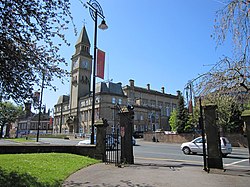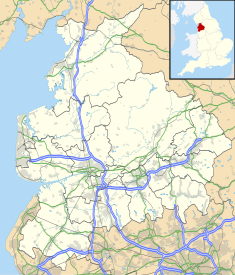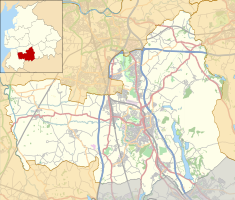Chorley Town Hall
| Chorley Town Hall | |
|---|---|
 Chorley Town Hall from St Laurence's churchyard | |
| Location | Chorley |
| Coordinates | 53°39′14″N 2°38′00″W / 53.6540°N 2.6332°W |
| Built | 1879 |
| Architect | John Ladds and William Henry Powell |
| Architectural style(s) | Italianate style |
Chorley Town Hall is a municipal building in Market Street in Chorley, Lancashire, England.
History
[edit]The first town hall, which was commissioned by a local mercer and philanthropist, John Hollinshead of Hollinshead Hall, was built on the east side of Market Street and completed in 1802.[1][2] It accommodated the local public offices as well as the local lock-up.[1] After the first town hall became too cramped, civic leaders decided to procure a new town hall: the site they selected on the west side of Market Street had been occupied by the Gillibrand Arms Public House.[3][4]
The new building, which was designed in the Italianate style by John Ladds and William Henry Powell, was completed in 1879.[5][6] The design involved a symmetrical main frontage with five bays facing onto Market Street with the end bays slightly projected forward; the central section, which also slightly projected forward, featured a doorway on the ground floor with brackets supporting a pediment containing a carved tympanum with a tall clock tower above (the clock and bells were by Gillett, Bland & Co.); there were sash windows on the first and second floors. The principal rooms were a large assembly hall, which later became known as the Lancastrian Room, the council chamber and town clerk's office.[7]
The town hall became the headquarters of the new Municipal Borough of Chorley in 1881.[1] In the early years the basement was used for a butter market and, in the early 20th century, the assembly room was used as a cinema.[8] Meanwhile the old town hall was demolished in the 1930s.[9] The building remained the local seat of government when the enlarged Borough of Chorley was formed in 1974.[10] In the 1980s, a control centre was established in the basement for the protection of civic leaders in the event of a nuclear attack.[9] Although most council officers and their departments relocated to the Civic Offices in Union Street in the late 20th century,[11] council meetings continued to be held in the town hall.[12]
An extensive programme of refurbishment works at the town hall was completed in 2005.[13] The works, which were designed by Seed Architects, involved re-instatement of the main entrance under the clock tower and the creation of a glass-roofed atrium with glass passenger lifts to facilitate easy movement of customers within the building.[14] After several incidents involving damage to facilities and abuse of staff, the Lancastrian Room ceased to be available for private hire in 2009.[15]
References
[edit]- ^ a b c Farrer, William; Brownbill, J. (1911). "'Chorley', in A History of the County of Lancaster". London: British History Online. pp. 129–149. Retrieved 28 November 2020.
- ^ "Significant dates in Chorley's Past". Chorley Historical and Archaeological Society. Retrieved 28 November 2020.
- ^ "Ordnance Survey Map". 1848. Retrieved 28 November 2020.
- ^ "Census Data". 1841. Retrieved 28 November 2020.
- ^ "1875 – Town Hall, Chorley, Lancashire". Archiseek. Retrieved 28 November 2020.
- ^ "Chorley, Lancashire". The Comprehensive Gazetteer of England & Wales, 1894-5. Retrieved 28 November 2020.
- ^ "Kelly's Directory of Lancashire". 1905. Retrieved 28 November 2020.
- ^ "Chorley Town Hall". Cinema Treasures. Retrieved 28 November 2020.
- ^ a b "National Heritage Open Days co-ordinated by the Civic Trust: conducted tour of Chorley Town Hall". Chorley Historical and Archaeological Society. Retrieved 28 November 2020.
- ^ Local Government Act 1972. 1972 c.70. The Stationery Office Ltd. 1997. ISBN 0-10-547072-4.
- ^ "No. 56109". The London Gazette. 5 February 2001. p. 1437.
- ^ "Full Council Meeting" (PDF). Chorley Council. 17 September 2019. Retrieved 28 November 2020.
- ^ "Post reviews its FoI blitz". Press and Gazette. 4 August 2005. Retrieved 28 November 2020.
- ^ "Chorley Town Hall". Seed Architects. Retrieved 28 November 2020.
- ^ "Birthday bashes banned after havoc at Chorley Town Hall". Lancashire Telegraph. 14 January 2009. Retrieved 28 November 2020.



